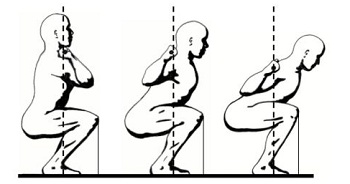Ok guys, I've been going through Starting Strength for the last two months and my squat has gone up pretty well. However, I've been reading Rippetoe's book and I'm starting to think I'm not going deep enough. I never feel sore in my glutes and I'm worried I'm not hitting them. One thing I don't understand is that a lot of people say not to lean forward when squatting. But going by the diagrams in the book and by my ACSM PT book, leaning forward seems like a requirement.
Rippetoe says to keep your upper body aligned at a 45 degree angle. The ACSM book states "the further the lifter leans forward from the trunk the further the weight acts from the axis of rotation at the hip." It continues "as the external resistance moves further forward horizontally, the resistance from the hip extensors is greater." That leads me to believe that I'm not leaning forward enough to get the bar above the mid-foot range but I was always told to keep everything more vertical. Is it ok to lean forward and to squat with that 45 degree angle?
I might have my answer here. The ACSM book says that situating the bar higher up on the shoulders stresses the knee extensors more than the hip extensors. I usually have the bar high up on my traps, so maybe that's why I don't seem to be hitting my hip extensors as much.
How much you lean forward will be a funcion of the angles of the hips and the knees. Those angles, in turn, will be a function of the position of the bar on the back as well as individual anthropometry, because the hip angle has to be adjusted so that the bar travels perpendicularly to the floor over the middle of the foot.
As you can see in this diagram (from Starting Strength 2nd Edition), the back is almost completely vertical in the front squat, since the bar is already over the middle of the foot in when standing just holding the bar. So in order to keep the bar path vertical, the back will also remain pretty vertical.
In the middle we see the high bar squat, with the bar sitting on the traps. The back angle is less vertical now, because there has to be some lean over to accommodate the bar path.
Finally we have a low bar squat, in which the bar is placed on top of the shoulders. The back angle is close to 45°, because this is necessary to keep the bar path vertical over the middle of the foot.
So yes, your back will be at a 45° angle (or close to it)
if you are doing low bar squats.
The result of this is that the hamstrings are much more engaged in the low bar squat, since they reach a high amount of tension at the bottom (below parallel) since the hips have to stick out to accommodate the back angle. This is what enables the low bar squat to utilize a significant amount of "hip drive", as well at a bounce from the bottom, which is why Rippetoe prefers this type of squat.
The "back must remain vertical" bit is just typical gym conventional wisdom, just like "going bellow parallel will wreck your knees", "look up when squatting", "don't lock out your knees", etc. It's just drivel that's passed on without any thought applied to it, but as such it doesn't really withstand any scrutiny.
All this info is in Starting Strength; I suggest you read and reread that book as it's a trove of knowledge. And it's knowledge that relies on mechanics and anatomy, not just a collection of "conventional wisdom".
If you want you can post a form check and we'll take a look at it.




